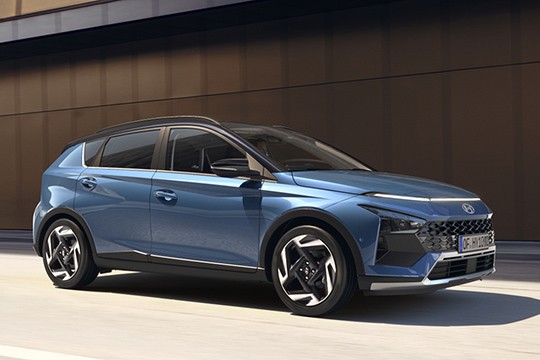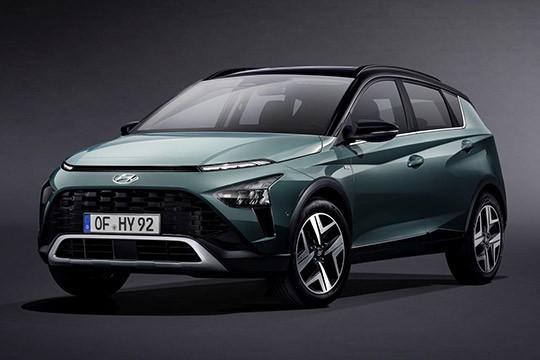HYUNDAI Bayon Models/Series Timeline, Specifications & Photos
First production year: 2021
Engines: Mild hybrid, Gasoline
Body style: SUV (Sports Utility Vehicle)
At the beginning of 2024, Hyundai introduced the refreshed version of its subcompact crossover model, Bayon, just two years after the model’s launch on the market.
Hyundai already had the K2 platform used for the i20 when it considered creating the Bayon on it. It jacked up the suspension, created a new bodywork, and called it a day. But the result was not something someone would guess that it was made in a hurry because it wasn’t. Moreover, its unveiling was delayed due to the pandemic situation, and Hyundai launched it in March 2021. Just three years later, the subcompact crossover vehicle got an update in terms of styling and safety features.
The Korean automaker completely changed the Bayon’s front fascia, creating an almost seamless light stripe for the daytime running lights placed at the lower edge of the hood. Even though the car was not designed to take its customers to the top of a mountain and back through difficult trails, it sported a more aggressive front bumper. Its piano-black middle section and the lower apron fitted with a silver trim that mimicked an underbody shield looked rugged. In addition, a set of side scoops that flanked the lower grille created an air curtain that enhanced the vehicle’s aerodynamics.
From its profile, the hatchback styling remained similar to the one from the non-facelifted version of the Bayon. Its side-sculptured door panels and the crease that crossed the car from the front fenders to the taillights remained the same. Still, Hyundai added new options for wheels, which were available in 16- and 17-inch sizes. The ascending waistline of the car was emphasized by a chromed trim that ran at the lower side of the window line. At the back, the raked-forward C-pillars sported the redesigned arrow-shaped taillights pointed inward. These were also visually connected via a red stripe that crossed the metallic part of the tailgate at the lower side of the rear window. Hyundai offered the 2024 Bayon with a choice of nine colors.
Inside, the automaker installed the same bolstered front seats that could keep its customers in place during high-speed cornering maneuvers. Still, the Bayon was not a sports car or a hot hatch. It was just a regular grocery-getter vehicle made to look aggressive but with a nice interior. On the dashboard, Hyundai installed a pair of 10.25-inch displays. The one in front of the driver was for the instrument panel, and the touchscreen atop the center stack was for the infotainment unit. Previously, the latter was available with an eight-inch size, but Hyundai ditched it. A high-quality Bose sound system with eight speakers was on the options list, proving that even if the car wasn’t priced like a premium vehicle, it could still provide upscale amenities. In terms of safety, Hyundai added the Blind Spot Collision-Avoidance Assist (BCA) that could brake the car it needed. In addition, a driver attention warning and a lane departure warning were fitted as standard.
While the Bayon might ring a bell only to the European customers, it doesn't mean anything for the rest of the world. Yet, Hyundai chose that nameplate for its 2021 crossover.
Bayonne is a resort in France, and its pronunciation sounds just like the Hyundai's crossover. Considering that, it might seem that the Bayon was a recreational vehicle, not a daily driver one. Yet it was, and even though it fought on the same segment as the Hyundai Kona, it tried to address different customers and lure them away from other brands.
The Bayon looked a lot bigger than the Kona, which didn't replace it, but it was similar-sized. Its front fascia sported the slim DRLs on the upper side of the bumper, well above headlights. A tall and wide trapezoidal grille covered most of the bumper, while a silver plastic trim mimicked a shield that protected the underbody. From its sides, it looked like a flame-surfacing concept, with various angles and panels sculptured to reflect light in all directions.
Inside, there was roomy enough for four adults, thanks to its compact-sized wheelbase. The Bayon featured a flat floor in the back, which was a good point if there were five people on-board. At the front, the driver enjoyed the multiple displays installed. Its instrument cluster featured a digital 10.25" display for all the information required for driving, while an 8" touch-screen found its place on top of the center stack for the infotainment system.
Under the hood, the Bayon featured a 1.0-liter turbocharged gasoline engine that provided up to 120 hp, combined with a mild-hybrid system. Hyundai offered the crossover with a five-speed manual, a six-speed manual, or a seven-speed automatic (dual-clutch) depending on the market and options.

